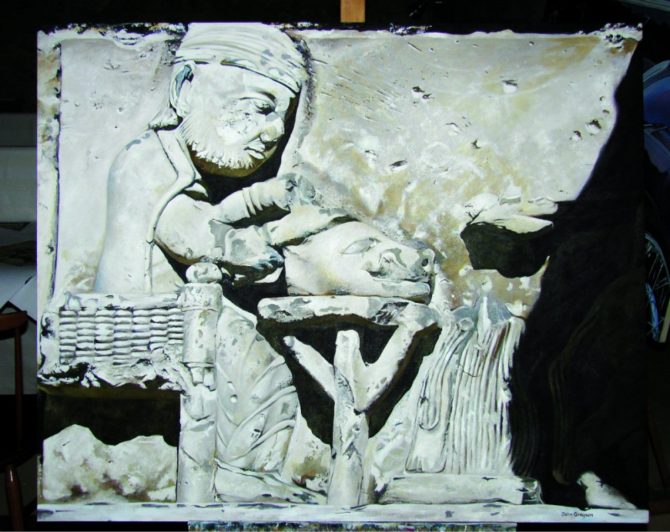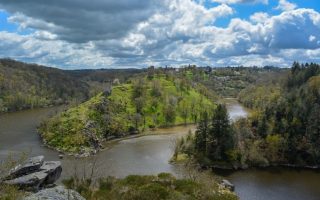Charente-Based Painter John Gregson

Aubeterre-sur-Dronne is a charming Charentaise village which clings to its clifftop and hillside location overlooking the Dronne River and the neighbouring département of the Dordogne. The picturesque combination of white limestone and terracotta roofs has long made the village a favourite for French artisans, summer tourists and resident expats escaping from chillier Northern climates.
But it was tourism of a different kind that first put the village on the map. St Jacques (St James in English) is the patron saint of Spain and was one of the first disciples to join Jesus of Nazareth. His remains are reputed to lie at Santiago de Compostela in Northern Spain and it is to this destination that Christian pilgrims have travelled on foot along the various ‘ways of St James’ from all over Europe since the 9th Century. Between the 10th and 12th Centuries, the Christian Church was a focal point of influence and power in French community life and the area known today as the Charente was at the crossroads of the old Pays d’Oc and the Pays d’Oil, thus ideally placed to benefit from a resurgent religion. With the Church at the centre of activity in medieval Charentais life there were funds available to build imposing churches in expensive stone, at a time when most buildings were built from wood.
Ancient Inspiration
In the 12th Century, during a time of relative peace and prosperity, the pilgrimages became even more established and organised, with resting points at notable churches and villages along the route. For residents of the villages en route, the pilgrims of St. Jacques were a kind of medieval precursor to the modern tourist, bringing money as they were in need of food, lodgings and even souvenirs.
Today the Charente is a much sleepier part of France, felt by many to exemplify la France profonde, a place where the traditions surrounding local community, agriculture and family life are still valued. The Charente inherits a legacy of many exquisite Romanesque churches which can still be seen and are in use across the region. One such is the Église St-Jacques in Aubeterre-sur-Dronne which remains a popular resting point for modern-day pilgrims on the Chemin de St. Jacques.
Aubeterre artist John Gregson was brought up in Preston in the north of England and has gradually migrated in a Southerly direction ever since. He graduated in Fine Art at Manchester and then later moved further south again to teach and manage Art & Design Education in East Sussex. In later life a love of France brought him in 1998 to the village where he now lives in the Charente. I met John and his wife Sue on the eve of their recent private viewing and soirée artistique to celebrate his new paintings. I asked John what attracted him to this part of the world in particular and he explained that it was “the quality of light, the climate, tranquillity and a spacious barn to develop into the ideal studio”.
Over the years John has refined his technique –moving gradually from a more classic abstract approach to something akin to photo-realism. For his new paintings he has found inspiration from the ancient limestone carvings on the local Église St-Jacques. These intriguing carvings can be found on many churches of the period. In medieval times the church was the most powerful and influential institution in people’s lives so the purpose of this kind of decoration was to inspire and help convert followers to the Church and to keep people away from vice and sin. The population of the time were largely illiterate – consequentially these images were powerful messages to the soul and to the imagination.
Early decoration was taken from nature or a geometric design, but as the stoneworkers’ skills improved they turned to scenes of people going about their daily lives or the depictions of the saints, the life of Christ and the teaching of good and evil, hell and heaven. The stone carvings also illustrate real and imaginary beasts, which held powerful meanings in the Middle Ages.
At the Église St-Jacques in Aubeterre the carvings on the west face feature signs of the zodiac, workers busy with their craft and farming activities during the seasons of the year as well as strange mythical beasts. The effects of time and weather erosion on the relatively soft limestone have taken their toll on the stone but for John Gregson it is this very detail ‘as found’ that inspires him. As he says, the thing that drives him to his long labours with the brush is “a search to capture light in reflection and its apparent distortion of form which transforms the ordinary”.
These new paintings work on exactly that level, transforming the quiet, time-worn carvings that sit just out-of-reach above the main church door, enlarging them and with microscopic accuracy bringing to life the unique texture and subtle dimensional changes. Some of the detail is so precise you feel you can almost reach into the painting and place your hand around the stone carving. The beautiful, almost monochromatic, colour palette adds to the mystique created by the partial erosion which leaves some of the figures half-formed and open to endless interpretation.
As I looked around their charming village house, lovingly restored in a tasteful and uncluttered style, I noticed that John’s spacious ‘studio in the barn’, replete with massive exposed beams and stone walls, has little by way of natural light. I was curious and asked him about his technique:
“I take photographs of objects, views and glimpses of things that interest me and use them to inform my interpretation of the image that I choose to portray – for example, a bunch of grapes freshly cut from the vine following a shower of rain, the bloom and droplets of water may be of interest but I might concentrate my interpretation on the translucence of the apparent transparency of the fruit against sunlight, resulting in a few grapes being the main focus of the composition, possibly requiring each one to be the size of a rugby ball in order to capture the detail.”
I watched him re-working a recent composition using a dry brush with his acrylic paints. To obtain the reflective quality in the work several layers of paint are applied in a relatively short time and the result allows the painting to display depth and tonal difference dependent on the light source focused on the canvas, bringing the subject to life.
To achieve these effects John needs a uniform light source which explains why he prefers electric light – it gives him a consistent light for the detail he needs and it means he can return to work at any time of day or night without compromising the painting.
I suggested to John that he had to be something of a saint himself to labour at these works over long periods of time in order to achieve the impressive effects. I was quite pleased with this analogy with St-Jacques, especially as John and Sue had recently walked a stretch of the Chemin in Spain themselves – but over a glass of good local red, John, who is an unpretentious kind of guy, soon kicked this fanciful notion into touch. The fact is that he is simply inspired by many of the everyday things he and Sue come across in their life in France and on their travels. Add to this John’s determination to further establish his reputation in the international art market – where he has found numerous collectors and enthusiasts – and you have the source of his motivation to put brush to canvas.
Not surprisingly this new series of artworks was exceptionally well received during the private view followed by an evening of fine dining and entertainment at the nearby Hostellerie du Périgord in Aubeterre, where his paintings are often on display.
With these latest works I feel convinced John will win even more admirers and collectors. He is on the right path, even if not the path of St-Jacques.
Originally published in the October-November 2013 issue of France Today
Share to: Facebook Twitter LinkedIn Email
Leave a reply
Your email address will not be published. Required fields are marked *



